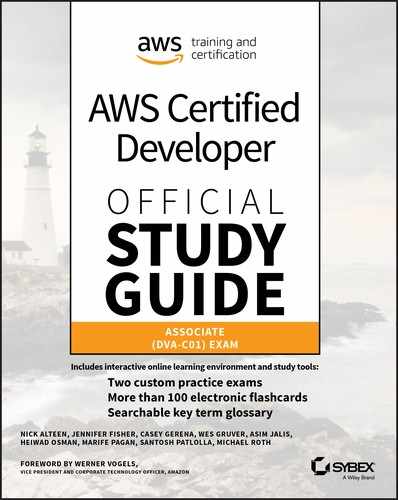What Does This Book Cover?
This book covers topics that you need to know to prepare for the Amazon Web Services (AWS) Certified Developer – Associate Exam.
Chapter 1: Introduction to AWS Cloud API This chapter provides an overview of how to use AWS Cloud API calls. The chapter includes an introduction to AWS software development kits (AWS SDKs) and the AWS global infrastructure. A review of AWS API keys and how to manage them using AWS Identity and Access Management (IAM) is also included.
Chapter 2: Introduction to Compute and Networking This chapter reviews compute and networking environments in AWS. It provides an overview of resources, such as Amazon Elastice Compute Cloud (Amazon EC2), and the network controls exposed through Amazon Virtual Private Cloud (Amazon VPC).
Chapter 3: Hello, Storage In this chapter, you will learn about cloud storage with AWS. It provides a review of storage fundamentals and the AWS storage portfolio of services, such as Amazon Simple Storage Service (Amazon S3) and Amazon S3 Glacier. The chapter also covers how to choose the right type of storage for a workload.
Chapter 4: Hello, Databases This chapter provides an overview of the AWS database services. The chapter provides a baseline understanding of SQL versus NoSQL. It also introduces concepts such as caching with Amazon ElastiCache and business intelligence with Amazon Redshift. The chapter also covers Amazon Relational Database Service (Amazon RDS) and Amazon DynamoDB.
Chapter 5: Encryption on AWS In this chapter, you will explore AWS services that enable you to perform encryption of data at rest using both customer and AWS managed solutions. An overview of each approach and the use case for each is provided. Example architectures are included that show the differences between a customer and an AWS managed infrastructure.
Chapter 6: Deployment Strategies In this chapter, you will learn about automated application deployment, management, and maintenance by using AWS Elastic Beanstalk. You will also learn about the various deployment methodologies and options to determine the best approach for individual workloads.
Chapter 7: Deployment as Code This chapter describes the AWS code services used to automate infrastructure and application deployments across AWS and on-premises resources. You will learn about the differences among continuous integration, continuous delivery, and continuous deployment, in addition to how AWS enables you to achieve each.
Chapter 8: Infrastructure as Code This chapter focuses on AWS CloudFormation and how you can use the service to create flexible, repeatable templates for a cloud infrastructure. You will learn about the different AWS CloudFormation template components, supported resources, and how to integrate non-AWS resources into your templates using custom resources.
Chapter 9: Configuration as Code In this chapter, you will learn about AWS OpsWorks Stacks and Amazon Elastic Container Service (Amazon ECS). OpsWorks Stacks enables you to perform automated configuration management on resources in your AWS account and on-premises instances using Chef cookbooks. You will learn how to add a Chef cookbook to your stack, associate it with an instance, and perform configuration changes. Using Amazon ECS, you will learn how to create clusters and services and how to deploy tasks to your cluster in response to changes in customer demand.
Chapter 10: Authentication and Authorization This chapter explains the differences between authentication and authorization and how these differences apply to infrastructure and applications running on AWS. You will also learn about integrating third-party identity services, in addition to the differences between the control pane and data pane.
Chapter 11: Refactor to Microservices In this chapter, you will learn about microservices and how to refactor large application stacks into small, portable containers. You will also learn how to implement messaging infrastructure to enable communication between microservices running in your environment.
Chapter 12: Serverless Compute This chapter reviews AWS Lambda as a compute service that you can use to run code without provisioning or managing servers. In this chapter, you will learn about creating, triggering, and securing Lambda functions. You will also learn other features of Lambda, such as versioning and aliases.
Chapter 13: Serverless Applications This chapter expands on the serverless concepts you learned in Chapter 12, “Serverless Compute,” and shows you how to architect a full-stack serverless web application. You will learn how to map server-based application architectures to serverless application architectures.
Chapter 14: Stateless Application Patterns This chapter expands on the concepts you learned in Chapter 13, “Serverless Applications,” by explaining how to design stateless applications. You will learn how to develop applications that do not depend on state information stored on individual resources, allowing for additional portability and availability.
Chapter 15: Monitoring and Troubleshooting This chapter discusses AWS services that you can use to monitor the health of your applications, in addition to changes to AWS resources over time. You will learn how to use Amazon CloudWatch to perform log analysis and create custom metrics for ingestion by other tools and for creating visualizations in the dashboard. You will also learn how to use AWS CloudTrail to monitor API activity for your AWS account to ensure that changes are appropriately audited over time. You will also learn how to use AWS X-Ray to create visual maps of application components for step-by-step analysis.
Chapter 16: Optimization This chapter covers some of the best practices and considerations for designing systems to achieve business outcomes at a minimal cost and to maintain optimal performance efficiency. This chapter covers scenarios for compute and storage, how to use a serverless platform, and what to consider for efficient data transfer to optimize your solutions. The chapter describes key AWS tools for managing and monitoring the cost and performance of your infrastructure. It includes code snippets, samples, and exercises to develop monitoring solutions and designs that integrate other AWS services.
